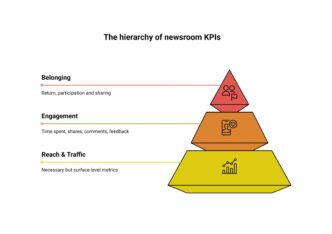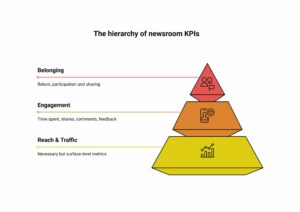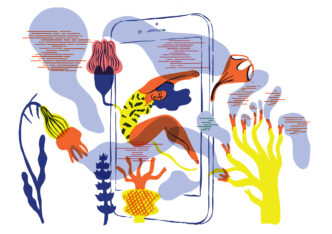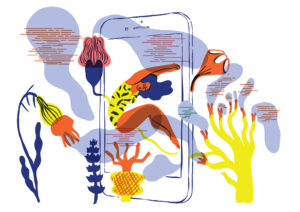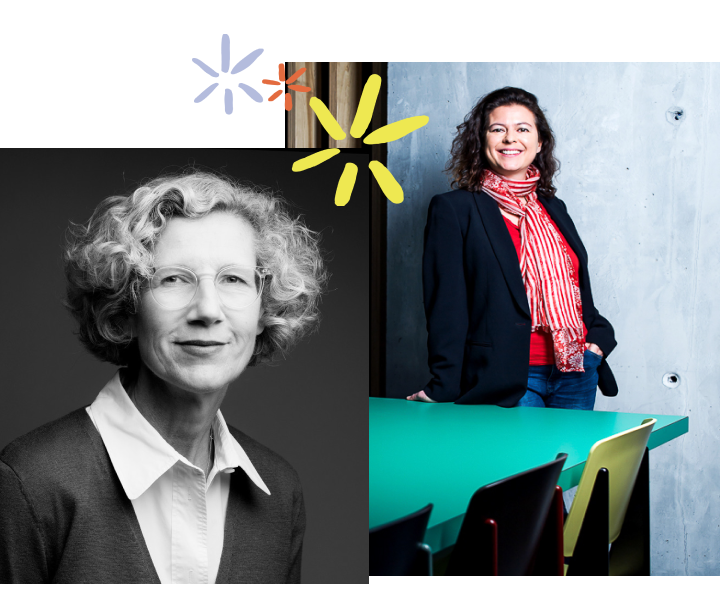

We met on a cold Friday morning, in a noisy café in Paris’ 15th arrondissement. Coffee in hand, Bérénice Lajouranie, Managing Director of the daily business newspaper Les Echos, accompanied by Violaine Degas, Digital Director, begins to share the inside story of their recent quest to reach new audiences. Recounting the context and vision behind this major digital project, I learn about the reasoning behind this work, how it unfolded, the KPIs measured and results attained.
Bérénice, thank you for agreeing to this interview! So you’re in charge of Les Echos, and your digital edition seems to be doing rather well – audience figures are still very high…
…and you rank 3rd among French business sites in the ACPM rankings, with 25 million visits in October 2023, far ahead of others in the industry, and very close to the top 2, which have significantly fewer, if any, premium articles closed to non-subscribers.
Why did you decide that you needed to reach new audiences?
Bérénice, Managing Director: It’s true that when people read us, they like us. Once we’ve managed to attract a reader, we keep them! We have two types of subscriptions: individual subscribers (who pay for it themselves), and B2B subscriptions for companies who offer a subscription to employees.
Today, Les Echos has 100,000 subscribers, 75% individual, 25% B2B. In the B2B segment, the renewal rate is close to 100%. Even on the B2C side, it’s very good. So, clearly, subscriber retention isn’t a priority for investing resources this year.
On the other hand, we’re finding it difficult to win over new readers.
This is partly due to brand image, and then perhaps because we have a somewhat generalist, somewhat specialist positioning. But also the conversion tunnel which, at the moment, can be imagined as a fancy champagne glass thanks to our relatively niche premium product positioning. Our goal is to move from the champagne glass to more of a martini glass – a wider entry funnel to go after audiences that are less obvious to us – young people and women, but also companies in certain sectors, under-represented in our B2B portfolio.
How did you decide which audiences were worth going after?
Bérénice: Firstly, by reviewing the profile of our current readership. Two-thirds of our audience are men and one-third women, with an average age of 50. So it quickly became clear that we needed to attract women and young people!
Violaine, Digital Director: We worked with Demain agency, coordinated by our publisher Marie Van de Voorde, putting everything we knew about our readership into an Excel spreadsheet. We interviewed our in-house teams before working with the agency to organize interviews with subscribers to create a gallery of personas.
Our young readers (who don’t have the typical profile of any young person) are aged between 20-30, are in or have completed higher education and could be described as a ‘young talent’ or ‘future executive/expert’. They’re the people who will help transform tomorrow’s business world.
And it’s this young reader segment who is particularly important to us and the future of our business. If we can prepare a qualified, engaged young audience, these readers may be our future loyal subscribers.
Bérénice: from a strategic point of view, we’ve reinvested in audience research. For years, we’d been very focused on web analytics. And now we’ve rediscovered the means for qualitative research, for listening to the voice of our readers. We have a lot of research underway.
Violaine: I think what it allowed us to do was to bring out the insight, the irrational side of the request. Something that obviously we weren’t going to find in our analytics…
When it comes to young people, we found a lot of the same things we’ve been saying everywhere: they’re pretty far removed from information, they see it as anxiety-provoking, they get their information from social networks in audiovisual formats. When they subscribe to Les Echos, we can see that their consumption is irregular. We see them more in tune with Echos START, our editorial offering for young professionals, which works well for them. They find it more accessible, and feel better represented by the subjects we cover, around the start of a career, a first job… Our aim is to bring them to Les Echos full subscription too.
We’ve really delved into the relationship between work and the company. We realized that this is a generation that sees work as a means to personal fulfillment. They’ve already made a sacrifice – their studies – and when they start working, they want a meaning to what they’re doing, they want a good salary and to learn new things. They experience work as a vector of freedom and autonomy, not as a sacrifice, and the protection of their private/professional life balance is essential to them. They also like to form their own opinions on social issues that affect them, such as environmental impact, or the role of AI, for example. And of course, they prefer short, accessible video or audio formats, which they consume mainly on social networks, where they’ve mastered the codes. We need to respond to a form of impatience…
Do you pass on all the insights you gather during these interviews to the editorial team to inform them of reader expectations?
Violaine: We operate as a multi-disciplinary working group: editorial, audience, product, distribution, data… all coordinated by the editor, and it works well that way. Clémence Lemaistre, the digital editor, is our link to the editorial team.
> You’ll also enjoy: How the customer centre at Bonnier News became a source of insight – and the tools we used to achieve this
So, what’s your plan to appeal to this young target audience?
Bérénice: We’re aware that it’ll take time for them to buy a subscription, so our aim is to get them to visit our platforms, website and mobile app, subscribe to our newsletters and find out what we do.
Violaine: What we’ve been working on a lot are formats and distribution. In concrete terms, that means a lot of videos!
We were already producing news formats, but we started working on more complete video formats which better showcase the editorial expertise. In this area, we were supported by the Upian agency, along with the digital editorial team and audience teams.
Bérénice: video isn’t part of the Les Echos culture, we’re really a print-oriented company – it wasn’t an obvious step for us to take!
Violaine: The workshops set up by our editorial and audience teams, those working with Upian, were a big hit and really beneficial for this project. Journalists discovered a new way of conveying their expertise with a different kind of storytelling. The first format we produced is called “Ça s’explique” – literally translated as ‘that’s explainable’. Because, as our digital editor Clémence puts it so well, “for every problem there’s a solution that’s simple, clear and wrong”. We want to show that we need nuance!
We’ve produced our first 4 episodes: one on the hidden benefits of inflation, a reportage format showing that cows can also help reduce pollution, one on why bicycles are no longer manufactured in France, and one on deciphering the success of the shop, Action. You can watch them on our Youtube channel:
In the last 3 months, these 4 videos have gathered 750,000 views, with a completion rate of 50% on YouTube and an average age between 25 and 35. Overall, all types of videos combined, we’ll generate three times more views in 2023 than in 2021 on our site or on platforms like Instagram or LinkedIn.
Bérénice: The subjects are very in-depth and serious… but the tone and design are new. It’s fresher and more accessible.
We tried to reproduce what we’d done with our podcasts, in particular “La Story”, which has become one of the best news podcasts, where we worked really well with the Binge studio and editorial team.
For this project, we closely followed Binge’s recommendations, which were to give ourselves the means to ‘go big’ with this project, committing to doing it well, including hiring 3-4 dedicated positions which, at the time, was a daring and costly gamble. But today, it’s working well, we’re still getting a good audience and we’re monetizing the podcast well. So it was the right thing to do!
For our videos, we try to do the same thing: work with external experts for the form and format, then onboard teams for writing the content.
How do you organize distribution of these videos?
Violaine: Broadcasting is a priority on the site. We’re working on a video template that hasn’t been released yet, so for the moment videos are included in a classic article template, but this will evolve.
Bérénice: The “La story” podcast I mentioned earlier is superbly linked in all our articles, so we need to do the same with the video!
Violaine: We also broadcast them on social networks (Instagram, Facebook, X), in a teaser format lasting a few seconds (each video is 8-10 minutes long). We’re currently studying which teaser format works best for each platform (carousel, short video showing highlights,etc…). The next goal will be to optimize distribution on YouTube and improve our channel.
Of course, we felt a good fit with Linkedin, where we already have a strong presence with a very loyal community and two newsletters, “Mes Echos de la semaine” by Nicolas Barré and “Le pitch START UP” by Charlie Perreau, which have a combined audience of nearly 1 million people, and where we’d particularly like to strengthen our support for young working people in their thirties.
We’re currently releasing 1 video a month, studying storytelling and the right time to post. We’re also analyzing the format and rate of distribution, with the goal of increasing the rate of production when we feel we’ve found the right way of doing things.
Did you make any new hires for this project?
Violaine: Upian’s role is to pass on skills to us internally (video editor, motion designer), so yes, we do need a video producer in particular, and this will be our next big recruitment.
But we’ve been working hard on Les Echos’ social media presence for several years now, and we’ve really put a lot of energy into it. So we’d already recruited Community Managers on the editorial side to adapt formats to each platform.
We doubled our reach on Instagram between September 2022-23 by working on both the form and content of our posts and stories. We’ve adapted our visual charter, left more room for infographics, videos and regular collaborations with the team at Datagora, one of our incubated start-ups specializing in democratizing public data, making it more accessible to as many people as possible. Instagram is an interesting platform for us – it has enabled us to rejuvenate our audience (the majority of which are under 35), but also to feminize it, another of our goals with this project.
On TikTok, Les Echos START, embodied by Faustine Mazereeuw and other Les Echos journalists she invites, brings together a community of over 50,000 subscribers, whose average age is between 25 and 34, with a perfect 50/50 gender split. A good example of what happens on this platform is the highly educational content produced by the START editorial team on certain types of French savings accounts, which has amassed 450,000 views. It’s proof that “serious” subjects interest young audiences too – they’re useful in their daily lives as first-time savers.
Which KPIs did you measure for this project?
Violaine: It’s pure image notoriety and branding, and that’s what we need. As soon as we can, we link to the site and not to Youtube, because we need to bring people back to our subscription funnel. This will probably involve a newsletter in the future…
Bérénice: For the “Ça s’explique” project, our KPIs are average age of viewers, completion rate of each video and the number of views. Each project has its own quantified goals. And twice a year, as a model student of the WAN-IFRA Table Stakes program, we often ask ourselves the question of “what should we stop doing?”
We have to stay on course, and not let ourselves get sidetracked!
And you don’t think you can calculate an ROI?
Violaine: as long as we don’t have the right mechanism to encourage people who come to see a video to sign up, it’s going to be difficult to assess…
What are your next steps?
Violaine: We’re obviously going to continue what we’ve started. On top of that, we want to…
- Understand how we can better align the START brand with the Les Echos brand, to pursue the same goal of attracting younger readers
- Increasing our ambitions in the video format, without deviating from our brand positioning
- Devising ways of registering these new users and measuring the number of people who discover Les Echos and consult it regularly, a prerequisite for more subscription-oriented actions
Have you ever considered opening the entry funnel through language – for instance making content in English to attract English speakers?
Bérénice: Not really. Where we could bring specificity is in the treatment of France in both macro and micro economics, but frankly I need to prioritize and don’t believe in the potential, given the complexity of the project.
And this is a huge part of my role, to settle on the macro subject that we’re going to work on over the next year, to know that this is where we’ll focus resources. This doesn’t mean that we don’t deal with the other subjects, but that we choose the one on which to concentrate.
I’m constantly being asked to lose direction. We’re in a very, very fast-moving world, in which we share a lot with others: that’s good, but it’s important not to lose focus!

